Nowadays, podcasts are more popular than ever. As more people try to multitask, podcasts are gaining popularity rapidly. They are perfect for the morning and evening commutes, long trips, or when working out. Listeners become fans of a particular podcast series and eagerly await the next episode.
Have you searched for a video on YouTube, pressed the play button just to hear the audio as you do some other activity, never having the intention of actually watching the video? This is a clear example that podcasts are gaining demand more than ever.
If you plan to start a podcast, keep in mind that it’s relatively easy to record podcasts with quality audio without needing expensive equipment. You can even use your smartphone to start.
But as your podcast grows, you might need to include more microphones and some other features to make it more professional. Choosing the best mixer for podcasting will make your recording and editing process much easier while delivering a better experience to your listeners.
In this post, we present the best audio mixers for podcasting that offer all the features you’d ever need to make a professional sounding podcast. Let’s delve in.
The Best Mixers for Podcasting
With the many options out there when choosing a mixer, which one is the best fit for podcasting? Here are the best ones specially designed for a podcasting production studio:
The Zoom Podtrak P8 Podcasting Mixer
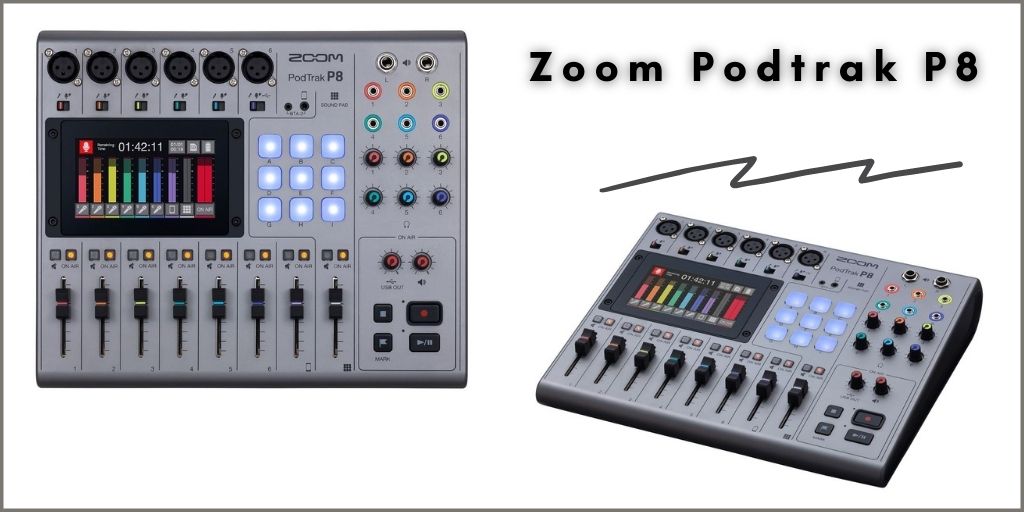
The Zoom Podtrak P8 is an all in one podcasting solution. With this mixer, you can mix, adjust tone, record, and edit, all with one tool without needing a laptop. Typically, to record a podcast, you would need several pieces of equipment, but with the Podtrak P8, all you need to do is connect the mics headphones and start recording right away.
This mixer offers many excellent features making it the best mixers for podcasting; let’s check them out.
Control and Adjust the Mix Using the Touchscreen
The full-color touchscreen display keeps the navigation simple. With it, you can have access to advanced features for adjusting sound, monitoring the mix, and after you are done recording, for editing the podcast straight from the mixer.
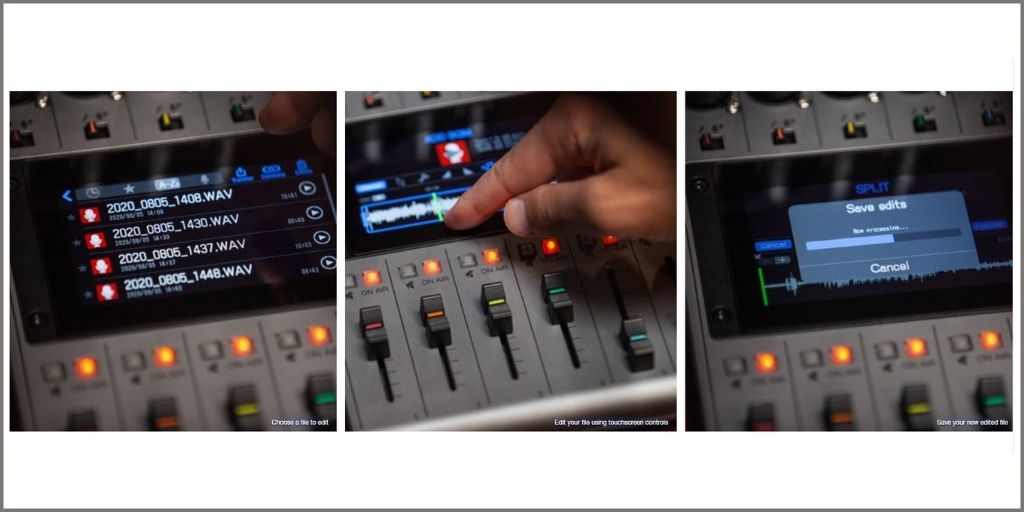
Its 4.3″ LCD touchscreen interface makes it easy to adjust the sound and make any changes quickly. Plus, the screen’s size is large enough to read what’s on the screen easily. The display can be configured in one of six different languages: English, French, German, Spanish, Italian, or Japanese.
It Comes With All the Ins and Outs for up to 6 People
You can use one or up to six mics depending on how many guests you have on your podcast. The P8 provides six high-quality mic preamps for excellent sounding recording. Each channel comes equipped with phantom power, which can be turned on or off via a dedicated switch to enable condenser microphones.
The Podtrak P8 also provides six dedicated headphone outputs. Each with its color-coded knob for controlling the volume.
Everything on this mixer is color-coded for easy access. Each fader slider and headphone knob provides a color code that can be traced on the display. That way, if you need to access functions on a specific channel, you will quickly find it and address it as needed.
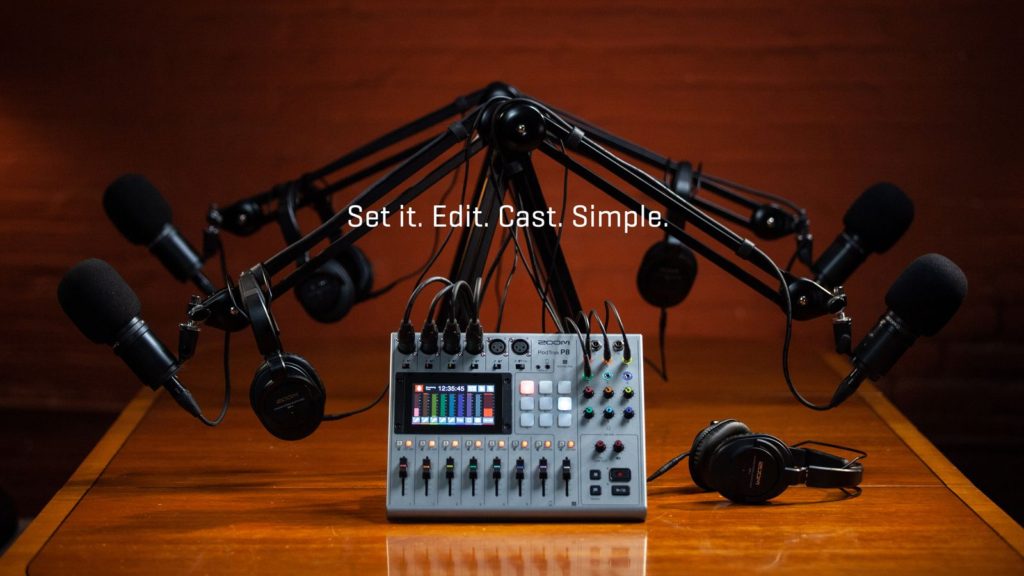
A Dedicated Call-In Channel
A useful feature is the ability to connect a phone to the mixer to receive phone calls. The call-in channel has its dedicated slider to control the volume. Everyone connected to the mixer will hear the caller, and the caller will listen to everyone clearly. At the same time, the whole conversation is recorded for the podcast.
The phone can be connected using a cable or wirelessly via Bluetooth. Bluetooth connectivity requires the Zoom BTA-2 adapter, sold separately.
Do you need to add a second caller from Skype or add another person from Zoom, Google Meet, or Microsoft Teams? No problem, you can connect your computer via USB to channel six by switching it to USB mode and control the volume of the incoming call. This feature will enable you to record any guests straight from your computer.
To automatically prevent echo and feedback from the caller’s phone, the P8 uses a Mix-Minus function. This means that the audio fed back to the phone includes the mix from all the channels minus the phone’s incoming audio. That way, the caller can listen to the conversation without echoing his voice, reducing the system’s feedback.
Make Your Podcast Standout With the 9×4 Assignable Sound Pads
Assign up to 36 sounds to the nine silicon touchpads. The P8 comes with 13 preloaded sound effects that include applause, laughter, and more, but you can easily change them or add your own using the P8’s software.
You can add additional sparkle and originality to your podcast with the sound effects, making you stand out from the rest.
Adjust the Sound to Suit Your Taste
With the P8, adjusting the sound quality of each channel is straightforward. All you have to do is select the channel on the touchscreen and from the menu, move the tone slider until it sounds the way you want.
When using the PodTrack, if the tone slider is in the middle, both the low and high frequencies will be slightly emphasized. If the sound needs more brightness, move the slider to the right for more treble. For emphasizing the lows, move the slider to the left (Bass). By Double-tapping the slider, it resets it to the default value.
Enables Your Voice to Have More Presence
While recording a podcast, you want to make sure that the volume is constant throughout the recording. Sudden changes in audio levels, distortion, or excessive sibilance are very annoying to the listener.
The P8 comes with a compressor, limiter, de-eser, and low-cut filter available for each channel to enable you to control all of these issues.
As its names suggest, the compressor “compresses” the input signals when they exceed a set level, making them quieter and evening out the overall volume.
The limiter automatically prevents distortion in the sound by reducing input signals that have excessive levels.
A de-esser is a tool that significantly reduces or eliminates sibilance from vocal sounds. Sibilance is an unpleasant tonal harshness that can happen during consonant syllables. Example of sibilance are the “s”, “z”, “ch”, “j” and “sh” sounds. When using condenser microphones, sibilance can become a problem. The P8 solves this problem for you on the spot.
The Podtrack P8 provides you with all of these tools so that your podcast sounds like if it’s recorded in a studio, at a fraction of the cost.
Automatically Reduces Noise
While recording live, if there is background noise, as more microphones are on, more noise will be picked up. To reduce it, in the “On Air” screen, select Noise Reduction to automatically turn down the mic levels for tracks not in use, helping reduce the background noise.
It Serves as a USB Audio Interface for Windows and Mac
Turn the Zoom PodTrak P8 into an advanced home studio by connecting it to your laptop with the included USB Type-C cable. Load your favorite DAW (Digital Audio Workstation) software and start laying down tracks right away.
The P8 provides a 2-input, 2-output configuration when functioning as an interface while connected to a computer. You can use it for recording or live streaming in this mode, allowing you to use the mixer on platforms like Twitch, Youtube, Etc.
Zoom PodTrak P8 Demo
More Features Worth Mentioning
- Record up to 13 tracks simultaneously
- Individual volume sliders, mute buttons, and “on-air” indicators for each channel
- Mix-Minus function automatically prevents echo and feedback from callers phone
- Onboard editing
- 2-input, 2-output USB audio interface
- Class-compliant mode for iOS compatibility
- Battery power provides up to two hours of use with four AA batteries
- Records directly to SD, SDHC, and SDXC cards up to 512GB
- 16-bit /44.1kHz audio in WAV format
- The mixer is powered with a 5V DC power supply (included) / 4 x AA Batteries / USB bus-powered
Rode Rodecaster Pro
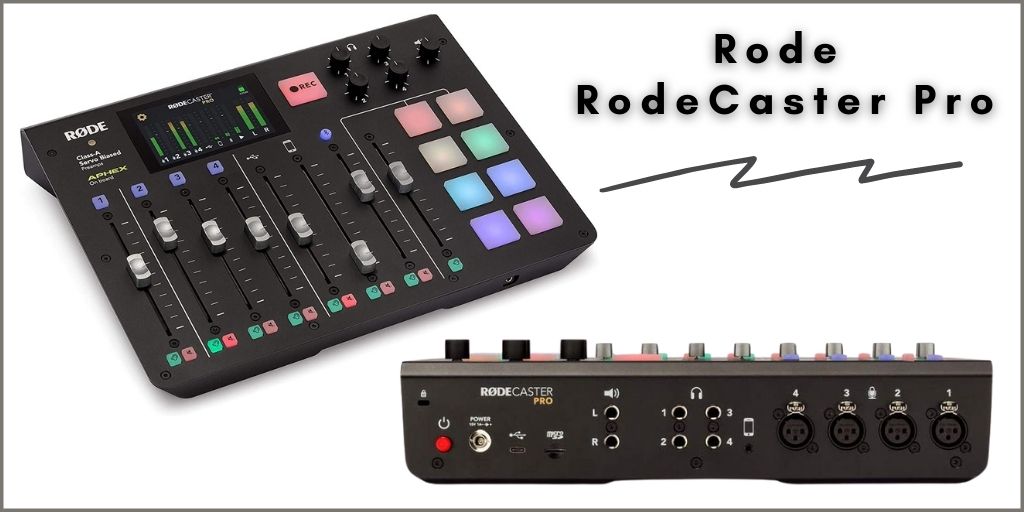
The Rodecaster Pro from Rode is a fully integrated podcast studio production and one of the best mixers for podcasting. Whether you are a beginner or seasoned podcaster, this mixer will make your journey as a podcaster very easy while delivering excellent results for your audience.
It features superb sound quality plus comes with all the features you’ll ever need as a podcaster. Let’s take a closer look at this fantastic podcasting mixer.
Easy Setup to Start Recording in Minutes
To start recording your podcast, all you have to do is connect the microphones and headphones for each presenter, insert a Micro-SD card, and start recording without needing a computer. This mixer offers up to 4 channels for connecting mics. It accepts both dynamic and condenser microphones. It also comes equipped with phantom power for your condenser mics.
It features four high-quality Class-A preamps as the ones found in professional broadcast mixers delivering crystal clear sound that enhances the recording’s sound quality. Thanks to its automatic level control setting, the sound will always be spot on, reducing the setup time.
All of its controls are very intuitive and simple to use. By spending a few minutes using the mixer, you will get to know the ins and outs and be familiar with all the features.
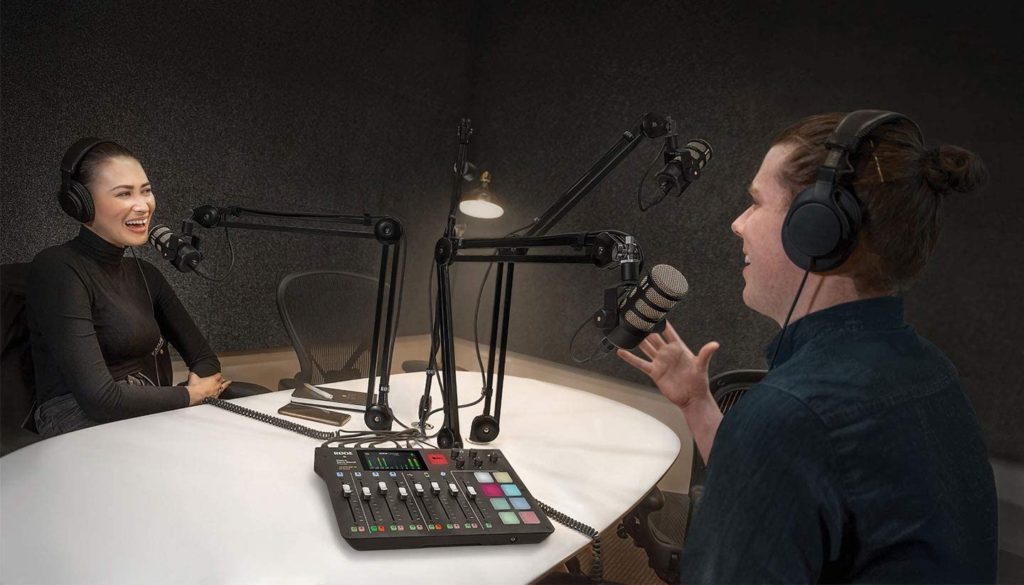
It Comes with Powerful Processing Effects
When using regular mixers for recording podcasts, sometimes, the overall sound volume is not constant. If a compressor is not available at the moment of the recording, sudden changes in audio levels are common. This can happen if the presenter gets away from the mic or gets too close to the mic.
Some people can have pronunciation sibilance, which becomes a challenge when editing. With the Rodecaster Pro you’ll get a powerful library of processing effects included with the mixer to help you achieve a clean, crisp audio recording on the first take every time.
These effects include a compressor, de-eser, high-pass filter, noise gate, and ducking, all easily accessible via the LED touchscreen.
In some cases, you get only one shot at recording a podcast, especially if you get a guest that has a tight schedule. Make sure you have the necessary tools to achieve a quality recording on the first go, and the Rodecaster Pro is the best podcasting mixer to achieve just that.
Programmable Pads for Sound Effects, Music, Commercials, and More
With the RodeCasyer Pro you get eight programmable touchpads that are instantly triggered when pressed. Each bank can store up to 8 sounds for a total of 64 sounds.
You can easily record sound directly to the pad from any of the mixer’s inputs or simply assign any audio from your computer, using the Rocaster’s companion software.
Add sound effects such as applause, laughter, screams, etc. or use to pad to store your jingles or commercials.
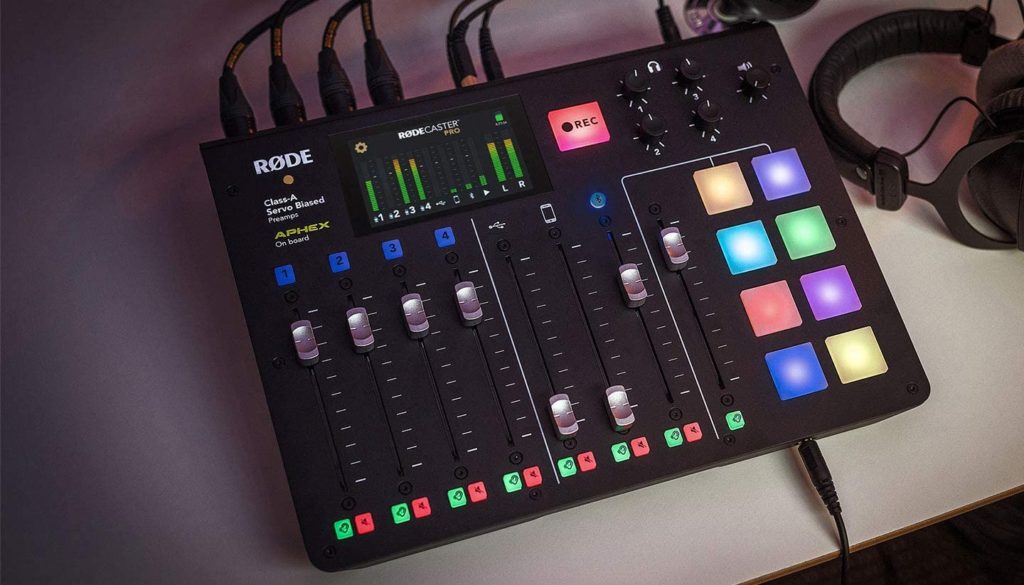
Rode RodeCaster Pro Demo
Use it as an Audio Interface
Turn your Rodecaster Pro into a powerful recording studio in no time. Just connect it to the computer using a Type-C USB cable, load your favorite DAW software, and start recording right away.
Rode just released a firmware upgrade that turns the Rodecaster Pro into a multitrack recording device. It records the live stereo mix plus each individual source on the Micro-SD memory card. Just make sure that the memory card has fast enough write speeds so that everything runs smoothly.
Besides, you could use the RodeCaster Pro for your live streams on platforms like Twitch, YouTube, etc.
TC-Helicon GO XLR
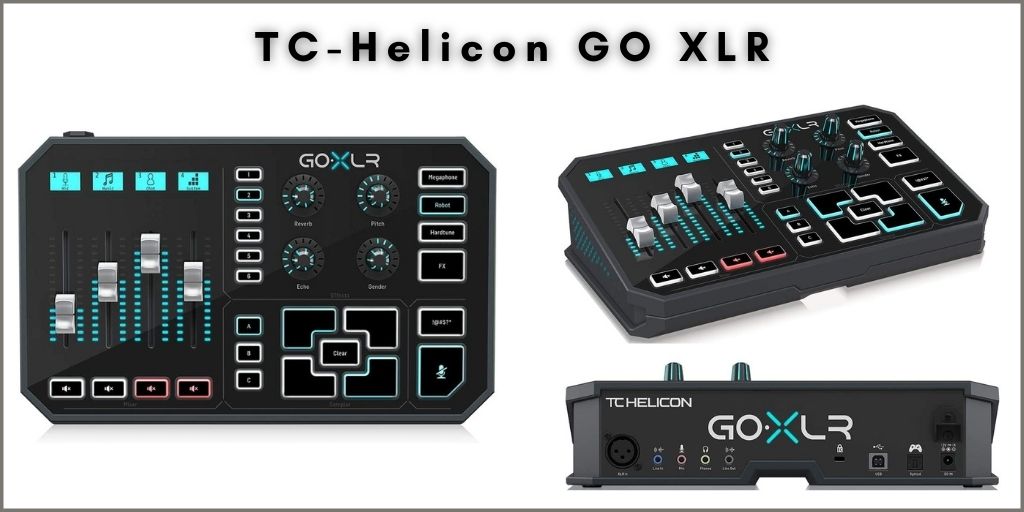
Another excellent product for podcasters or streamers and one of the best mixers for podcasting is the TC-Helicon GO XLR. Although originally designed for gamers and streamers, it comes bundled with many features that make it perfect for a solo podcaster who needs a reliable mixer to record or stream a podcast.
Provides a Winning Combination of Features for Podcasters and Streamers
With the GO XLR, you can connect a dynamic or condenser microphone. Use the companion app to turn on or off the phantom power.
It got enough inputs for all your audio sources if you are a solo podcaster. Connect your mic, lavalier, computer, and gaming console all at the same time. Use the mixer the control the volume for each device.
Add Sound Effects to Your Podcast or Live Stream
With the dedicated sampler section available on the app, create audio clips, add sound effects, jingles, and commercials. Then, assign them to the 12 available banks controlled from 6 dedicated pads.
With the GoXLR app, it’s easy to import any audio sample and trim them to time.
Provides Powerful Processing Broadcast Effects
Your audio will always be spot on with the GO XLR podcasting mixer, thanks to the vocal effects that come with it. Choose from compressor, de-esser, gating, and equalizer to ensure that your voice always sounds at its best.
To make your podcast even better, you also get hard-tune vocals effects. You can make your voice sound like a robot, megaphone, and the availability of gender and pitch controls. There is no end to the vocal tones you can generate when using these features from the TC-Helicon GO XLR mixer.
TC-Helicon GO XLR Demo
Other Features Worth Mentioning
- All-in-one desktop rig for podcasters and online broadcasters
- 4-channel mixer for all your audio sources
- Customizable motorized faders with LCD scribble strips that give you ultimate control
- Soundboard and recorder to cue bumpers and riff on-the-fly samples
- Studio-quality vocal effects used by pro musicians
- Premium low-noise Midas mic preamp for professional audio quality
- Full RGB lighting control to fit with your ambiance
- “Cough” button to instantly mute yourself
- Simple, easy-to-use controls get you up and running quickly
- PC app lets you control and recall all of your settings
Maono Maonocaster E2 – Portable Podcasting Mixer
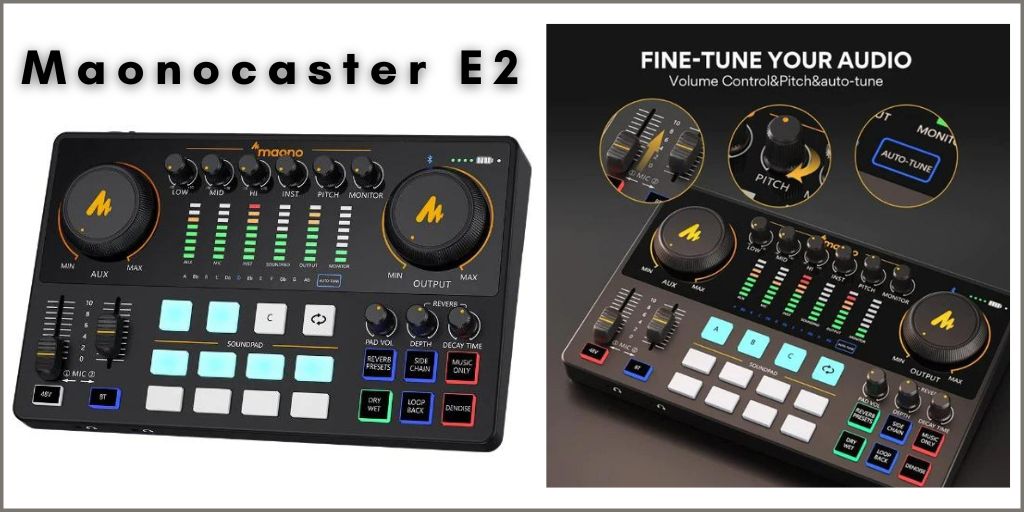
If you are starting a podcast or are a content creator with a tight budget, then the Maonocaster E2 is an excellent option. This is because it is a portable, integrated audio production studio that is easy to use, small, and compact.
What’s more, it comes with an internal 2000mAh rechargeable battery that should give you between 4 and 6 hours of operation under normal use—making it perfect when traveling. To charge it, you can use any 5VDC, 1Amp charger with a USB-C cable, or any power bank you use to charge your phone.
Simple Setup for Easy Podcast Recording
The Maonocaster E2 has two microphone inputs, one XLR, and one 3.5mm input. It also features a 1/4” instrument input if you want to record your guitar or any other instrument. The two mics have a slider volume controller, and the instrument input has a knob level controller.
You can connect a headset using a 3.5mm cable on Mic 2. This is handy if you don’t want to carry two microphones each time you are interviewing a guest.
The E2 comes with the standard 48V phantom power, which is essential if connecting condenser microphones.
Mic 1 is the XLR connector in which you can connect a condenser or dynamic microphone. Next to it is a button labeled “Mic 1 Setting,” in which you can select between condenser and dynamic mics. Plus it offers a gain boost on dynamic microphones.
If you are using a lower gain dynamic mic, you can increase the gain up to 60dB by flipping the button. This comes in handy, especially if you are using ribbon microphones. Make sure to turn off the phantom power if you use a classic, old ribbon mic. Phantom power can ruin them.
Headphones and Monitoring Feature
To monitor the recording, the E2 has two 3.5mm headphone jacks that can be used to connect two separate headphones. The volume for both headphone outputs is controlled by a single knob, which is a disadvantage because each person should be able to set the volume to their liking.
You could connect the mixer to a pair of powered speakers using the “Live Output 1” and “Live Output 2” 3.5mm connectors.
If you prefer to connect the mixer to studio monitors instead of headphones, you can connect a 3.5mm cable to your powered monitor and use the monitor knob to control the volume.
Another great feature is the Bluetooth connection which can be used to stream music or audio from your smartphone.
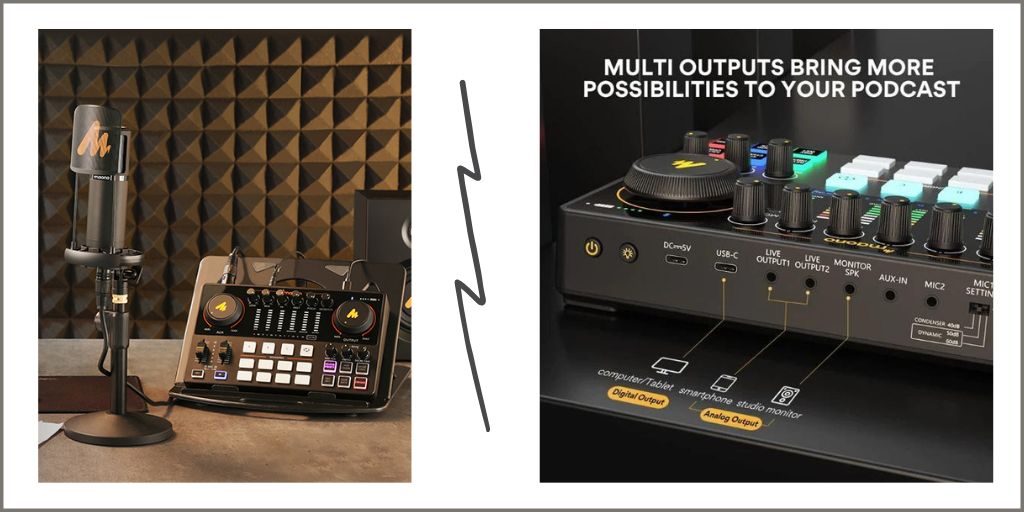
Features that Stand Out
The Maonocaster E2 has many features that stand out from the other podcasting mixers at this price range. It offers a 3-Band EQ, Sound Pads, Effects, Pitch Changer, and Auto-Tune. Let’s dive in some more into these features.
The E2 has a three-knob audio equalizer for Low, Mid, and Hi frequencies. One thing that stands out is that there are VU meters that show you at what level each EQ knob is set to. To see the level of each EQ, move the knob for each EQ band, and LEDs will light up depending on their respective levels.
There are eight programmable sound pads that you can use to record intros, outros, or store sound effects which can come in handy when recording a podcast or streaming your audio live.
It also comes with several reverb presets that you can use to give more space to the recording.
A pretty cool feature is the Pitch changer. It basically changes the tone of your voice, whether you are singing or speaking. All you have to do is move the pitch knob to the left for a lower, deeper voice or to the right for a higher pitch voice.
The Auto-Tune option is perfect if you are using the E2 for recording or streaming live music. You can change the voice at semitone increments which can be handy if for some reason, you can’t reach a specific note or if you make auto-tune a feature of your voice, as many artists use it nowadays.
Please note that the auto-tune feature is not professional-grade as this is just an entry-level mixer but offers many features for a reasonable price.
To activate the auto-tune feature, there is a touch button labeled “Auto-Tune,” just touch it to activate it. To change the tone, touch it again, and it will toggle between the different tones.
Recommendations
It would be nice to have at least two XLR inputs, especially if the mixer is used for podcasting. Another improvement that can be made to the E2 is to have separate knobs for each headphone; that way, each person can set the volume to their liking.
It would also help to include an SD card slot to record the podcast or live stream straight into the memory card, that way you can record without using a DAW software.
Besides that, the Maonocaster E2 is an excellent entry-level mixer for podcasting, especially at that price range. You get a whole bunch of features making it very attractive to buyers.
Final Thoughts
Remember that the best mixer for podcasting should make the whole process simpler and more straightforward. You’d want an all-in-one podcasting solution with less hardware, as it simplifies the setup, editing, and publishing process while delivering professional quality.
Although the Maonocaster E2 and the TC-Helicon GO XLR offer excellent features, they are limited to being used by a solo podcaster and one guest at max.
Another disadvantage of the E2 and the GO XLR is that you need to connect it to a computer to record the audio using a DAW software, as they don’t record straight to a memory card like the Podtrack 8 and Rodecaster Pro. Furthermore, many of the features require the app for them to function.
If your podcast is streamed live and you know that you won’t need more than two microphones for your podcast, then the Maonocaster E2 and the TC-Helicon GO XLR would be perfect. But, if you plan to scale to a point where you might want to have several guests on the podcast, I recommend going with the Zoom Podtrak P8 or the Rodecaster Pro, as they are standalone options that offer better features, quality for about twice the amount.